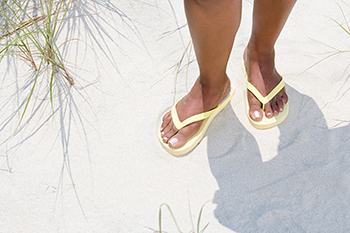
Many people choose to wear flip-flops when the summer months arrive, despite knowing they are not the best type of shoes to wear. They are available in a variety of styles and colors, and are easy to slip on, but frequent use may damage the feet. Most flip-flops are not supportive and are held together by a thin strip of rubber or material that lies between the big toe and the second toe. There are a few styles that can be considered which may contradict this reasoning. These can include flip-flops that have a flexible sole that can help to enhance foot strength, and have a wide toe area where the toes can move freely. A well-designed flip-flop may be able to keep the shoe on the foot, without having the toes ache. If you would like more information about the benefits of wearing flip-flops, please consult with a chiropodist who can answer any questions you may have.
Flip-flops, though they may seem harmless, are bad for your foot health. If you would like to learn more about the many problems that can be caused by frequent flip-flop wear, please consult with one of the specialists from Thornhill Foot Clinic. Our chiropodists can help you maintain the health of your lower limbs and your mobility.
Flip-flops are the quintessential summer shoe, seemingly perfect for the beach or pool. Unfortunately, these flimsy shoes are not a good choice when it comes to keeping your feet healthy.
Frequently wearing flip-flops is associated with:
Hammertoes
Bunions
Plantar fasciitis
Heel spurs
Cracked heels
Plantar warts
Athlete’s foot
Foot pain
Foot and ankle injuries
Gait changes
Leg, hip, and back pain
The best way to avoid these issues is to swap your flip-flops for more protective and supportive shoes. If you must wear flip-flops, wear them only for short periods of time.
If you have any questions, please feel free to contact our office located in . We offer the newest diagnostic and treatment technologies for all your foot care needs.





